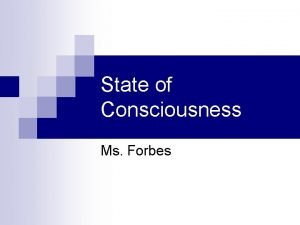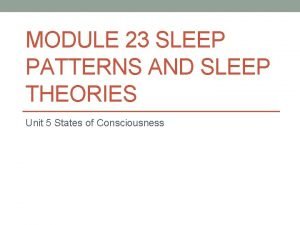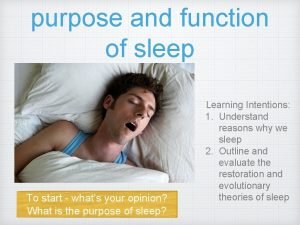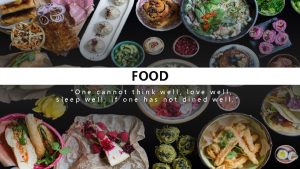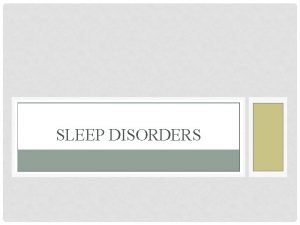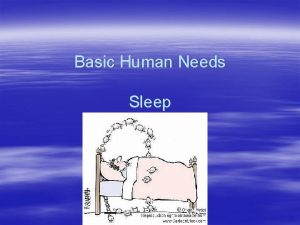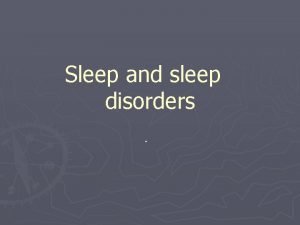FOOD One cannot think well love well sleep











- Slides: 11

FOOD “One cannot think well, love well, sleep well, if one has not dined well. ”

INTRODUCTION Nutrition may be defined as the science of food and its relationship to health. It is concerned primarily with the part played by nutrients in body growth, development and maintenance. Protein, carbohydrate and fat had been recognized early in the 19 th century as energy-yielding foods and much attention was paid to their metabolism and contribution to energy requirements.

CLASSIFICATION OF FOOD BY ORIGIN • Foods of animal origin • Foods of vegetable origin

CLASSIFICATION OF FOOD BY CHEMICAL COMPOSITION • • • Proteines Fats Carbohydrates Vitamines Minerals

CLASSIFICATION OF FOOD BY PREDOMINANT FUNCTION • Body Building Foods Meat, Milk, Poultry, Fish, Eggs, Pulses etc. • Energy Giving Foods Cereals, Sugars, Fats, Oils etc. • Protective Foods Vegetables, Fruits, Milk, etc.

NUTRIENTS Organic and inorganic complexes contained in food are called nutrients. They are broadly divided in to: Micronutrients: -vitamins -minerals Macronutrients: -proteins -fats -carbohydrates

PROTEINS ARE COMPLEX ORGANIC NITROGENOUS COMPOUNDS. THEY ALSO CONTAIN SULFUR AND I SOME CASES PHOSPHOROUS AND IRON. PROTEINS ARE MADE OF MONOMERS CALLED AMINO ACIDS. THERE ABOUT 20 DIFFERENT AMINOACIDS WHICH R FOUND IN HUMAN BODY. OF THIS 8 AA ARE TERMED “ESSENTIAL” AS THEY ARE NOT SYNTHESIZED IN HUMAN BODY AND MUST BE OBTAINED FROM DIETARY PROTIENS.

FUNCTIONS OF PROTEINS BODY BUILDING SYNTHESIS OF BIOACTIVE SUBSTANCES AND OTHER VITAL MOLECULES MAINTENANCE OF OSMOTIC PRESSURE REPAIR AND MAINTENANCE OF BODY TISSUES

FAT Most of the body fat (99 per cent) in the adipose tissue is in the form of triglycerides, in normal human subjects, adipose tissue constitutes between 10 and 15 per cent of body weight. One kilogram of adipose tissue corresponds to 7700 kcal of energy. as

CARBOHYDRATE Carbohydrate is the main source of energy, providing 4 Kcals per one gram Carbohydrate is also essential for the oxidation of fats and for the synthesis of certain non-essential amino acids

VITAMINS Vitamins are a class of organic compounds categorized as essential nutrients. They are required by the body in a very small amounts. They fall in the category of micronutrients. Vitamins are divided in to two groups: fat soluble vitamins. A, D, E and K and water soluble vitamins: vitamins of the Bgroup and vitamin C.
 Think big think fast think ahead
Think big think fast think ahead If you cannot measure it you cannot manage it
If you cannot measure it you cannot manage it The supernatural soliciting cannot be ill cannot be good
The supernatural soliciting cannot be ill cannot be good You can t manage what you don t measure
You can t manage what you don t measure If you can't measure it you can't manage it
If you can't measure it you can't manage it Love love jesus is love god greatest gift lyrics
Love love jesus is love god greatest gift lyrics Come sleep o sleep summary
Come sleep o sleep summary Adults spend about ______% of their sleep in rem sleep.
Adults spend about ______% of their sleep in rem sleep. Module 23 sleep patterns and sleep theories
Module 23 sleep patterns and sleep theories Module 23 sleep patterns and sleep theories
Module 23 sleep patterns and sleep theories Module 23 sleep patterns and sleep theories
Module 23 sleep patterns and sleep theories Many waters cannot quench love
Many waters cannot quench love







